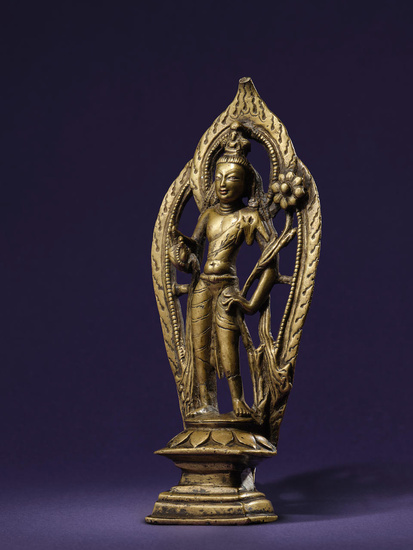A SILVER AND COPPER INLAID BRASS FIGURE OF PADMAPANI LOKESHVARA...
A SILVER AND COPPER INLAID BRASS FIGURE OF PADMAPANI LOKESHVARA
WESTERN TIBET, 11TH/12TH CENTURY
Himalayan Art Resources item no. 1895
20.3 cm (8 in.) high
藏西 十一/十二世紀 錯銀錯紅銅蓮華手觀音銅像
Avalokiteshvara, 'The Lord who Looks upon the World,' is seen in his standing Padmapani Lokeshvara form (lit. The Lotus Bearer) with a lotus blossoming by his left shoulder. He is regarded as the spiritual son of the Transcendental Buddha Amitabha, as indicated by the miniature Buddha in meditation that sits within his topknot. As the pure and perfect Bodhisattva of Infinite Compassion in Mahayana Buddhism, Avalokiteshvara willingly postpones his own highest enlightenment to save all sentient beings from suffering. He communicates this vow by raising his right hand in the gesture of fearlessness (abhaya mudra), offering devotees the chance to be reborn in a Buddhist paradise and subsequently liberate themselves from the endless cycle of samsara. As such, he represents the paradigm of perfected compassion, one of the key virtues a practitioner must develop towards his or her own Buddhahood.
Depicted with the handsome features of an eternally youthful prince, this fine sculpture of Padmapani Lokeshvara epitomizes the technical virtuosity of brass figures that were produced by skilled metalworking artisans between the 10th and 11th centuries of West Tibet. The artist conveys Avalokiteshvara's naturalism through the subtle shift of his weight to one side as he presses the splayed fingers of his left hand against his hip. His warm expression invites viewers to appreciate the silver and copper inlays enlivening his eyes and lips. The trefoil hair bun adorning his head is an iconographic detail that recalls Kashmiri models, appearing on two sculptures of Avalokiteshvara, including a seated triad bearing a dedicatory inscription to the reign of Queen Didda (980-1003) (both are published in von Schroeder, Indo-Tibetan Bronzes, 1981, pp. 122 & 128, nos. 18A & 21A). While the present work does share much of its spirit with Kashmiri bronzes, the absence of a sacred thread that would normally loop over the shoulder and the difference in its facial type, especially in its lips and nose, indicate that it was made by one of several Kashmir schools in western Tibet. Three comparable standing images are housed in monastery collections, including a figure of Avalokiteshvara in the Potala Palace and two figures depicting Maitreya and Manjushri in the Jokhang, with the last example being the closest comparison in its pose and modeling with the present work (see all three in von Schroeder, Buddhist Sculptures in Tibet, Vol. I, 2001, pp. 146, 161 & 162, nos. 37A-B, 44D & 45A-B).
Published
The Light of the Buddha: Buddhist Sculptures of the Palace Museum and Zhiguan Museum of Fine Art, Beijing, 2019, pp. 112-3, no. 19.
Exhibited
The Light of the Buddha: Buddhist Sculptures of the Palace Museum and Zhiguan Museum of Fine Art, Beijing, 23 October – 23 December 2018
Provenance
A Distinguished Asian Collector
View it on
Estimate
Time, Location
Auction House
A SILVER AND COPPER INLAID BRASS FIGURE OF PADMAPANI LOKESHVARA
WESTERN TIBET, 11TH/12TH CENTURY
Himalayan Art Resources item no. 1895
20.3 cm (8 in.) high
藏西 十一/十二世紀 錯銀錯紅銅蓮華手觀音銅像
Avalokiteshvara, 'The Lord who Looks upon the World,' is seen in his standing Padmapani Lokeshvara form (lit. The Lotus Bearer) with a lotus blossoming by his left shoulder. He is regarded as the spiritual son of the Transcendental Buddha Amitabha, as indicated by the miniature Buddha in meditation that sits within his topknot. As the pure and perfect Bodhisattva of Infinite Compassion in Mahayana Buddhism, Avalokiteshvara willingly postpones his own highest enlightenment to save all sentient beings from suffering. He communicates this vow by raising his right hand in the gesture of fearlessness (abhaya mudra), offering devotees the chance to be reborn in a Buddhist paradise and subsequently liberate themselves from the endless cycle of samsara. As such, he represents the paradigm of perfected compassion, one of the key virtues a practitioner must develop towards his or her own Buddhahood.
Depicted with the handsome features of an eternally youthful prince, this fine sculpture of Padmapani Lokeshvara epitomizes the technical virtuosity of brass figures that were produced by skilled metalworking artisans between the 10th and 11th centuries of West Tibet. The artist conveys Avalokiteshvara's naturalism through the subtle shift of his weight to one side as he presses the splayed fingers of his left hand against his hip. His warm expression invites viewers to appreciate the silver and copper inlays enlivening his eyes and lips. The trefoil hair bun adorning his head is an iconographic detail that recalls Kashmiri models, appearing on two sculptures of Avalokiteshvara, including a seated triad bearing a dedicatory inscription to the reign of Queen Didda (980-1003) (both are published in von Schroeder, Indo-Tibetan Bronzes, 1981, pp. 122 & 128, nos. 18A & 21A). While the present work does share much of its spirit with Kashmiri bronzes, the absence of a sacred thread that would normally loop over the shoulder and the difference in its facial type, especially in its lips and nose, indicate that it was made by one of several Kashmir schools in western Tibet. Three comparable standing images are housed in monastery collections, including a figure of Avalokiteshvara in the Potala Palace and two figures depicting Maitreya and Manjushri in the Jokhang, with the last example being the closest comparison in its pose and modeling with the present work (see all three in von Schroeder, Buddhist Sculptures in Tibet, Vol. I, 2001, pp. 146, 161 & 162, nos. 37A-B, 44D & 45A-B).
Published
The Light of the Buddha: Buddhist Sculptures of the Palace Museum and Zhiguan Museum of Fine Art, Beijing, 2019, pp. 112-3, no. 19.
Exhibited
The Light of the Buddha: Buddhist Sculptures of the Palace Museum and Zhiguan Museum of Fine Art, Beijing, 23 October – 23 December 2018
Provenance
A Distinguished Asian Collector



